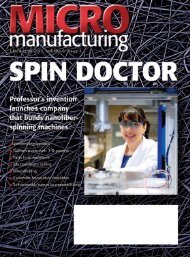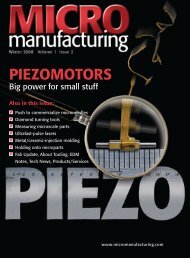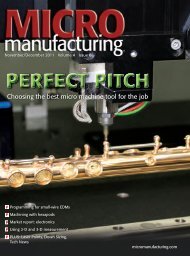to view as PDF - MICROmanufacturing
to view as PDF - MICROmanufacturing
to view as PDF - MICROmanufacturing
Create successful ePaper yourself
Turn your PDF publications into a flip-book with our unique Google optimized e-Paper software.
Prickly Situation continued<br />
in-vivo imaging and other potential<br />
biotech applications—in<strong>to</strong> the skin<br />
using microneedles made via 2PP.<br />
(The procedure is aimed at diagnosing<br />
and treating skin cancer.)<br />
Microneedles fabricated using 2PP,<br />
he explained, create pores in the<br />
15µm-thick stratum-corneum layer<br />
of the skin. The needles are hollow<br />
or “mosqui<strong>to</strong> f<strong>as</strong>cicle-shaped …<br />
created out of organically modified<br />
ceramic materials,” he said.<br />
The devices were tested on<br />
pig skin and allowed delivery of<br />
quantum dots <strong>to</strong> the deep epidermis<br />
within 15 minutes, Narayan said. By<br />
comparison, “<strong>to</strong>pically applied carboxyl<br />
quantum dots remained on the <strong>to</strong>pmost<br />
50μm of the skin and demonstrated poor<br />
penetration.”<br />
Narayan believes the new 2PP process<br />
is best-suited <strong>to</strong> m<strong>as</strong>s fabrication. That’s<br />
DOWNsizing<br />
continued from page 19<br />
study published in the April 25 issue<br />
of the Journal of the American Medical<br />
Association showed that cardiacdevice<br />
infective endocarditis (CDIE)<br />
incre<strong>as</strong>ed 210 percent from 1993 <strong>to</strong><br />
2008. Of the 177 patients enrolled in<br />
the study who developed CDIE, nearly<br />
a quarter of them died <strong>as</strong> a result.<br />
“The high rates of mortality emph<strong>as</strong>ize<br />
the need for improved preventive<br />
me<strong>as</strong>ures,” the study concluded. “Given<br />
that the number of cardiov<strong>as</strong>cular<br />
implantable electronic devices placed<br />
are incre<strong>as</strong>ing rapidly, further studies<br />
on the prevention and treatment of this<br />
serious complication are needed.”<br />
As it turns out, silicon technology<br />
once again may be the key <strong>to</strong> safer,<br />
much smaller and less costly pacemakers<br />
by making it possible <strong>to</strong><br />
eliminate the lead wires that run from<br />
the device <strong>to</strong> the heart.<br />
Minneapolis-b<strong>as</strong>ed Medtronic Inc.’s<br />
Dr. Stephen Oesterle, senior vice president<br />
for medicine and technology,<br />
can readily be found on YouTube<br />
discussing a pill-size pacemaker that<br />
could be inserted in<strong>to</strong> the heart via<br />
40 | MAY/JUNE 2012 | <strong>MICROmanufacturing</strong><br />
L<strong>as</strong>er Zentrum Hannover<br />
Microneedles fabricated via multifocus, two-pho<strong>to</strong>n<br />
polymerization.<br />
because it can be used <strong>to</strong> process a variety<br />
of pho<strong>to</strong>sensitive materials, including<br />
acrylate-b<strong>as</strong>ed polymers, organically<br />
modified ceramic materials, zirconium<br />
sol-gels and titanium-containing hybrid<br />
materials. “Many of these materials are<br />
widely available and may be obtained at<br />
This illustration, b<strong>as</strong>ed on Medtronic's<br />
online presentation, depicts the size and<br />
shape of a pacemaker sitting a<strong>to</strong>p a penny.<br />
Currently under development, the device<br />
will eliminate the need for lead wires.<br />
a catheter and attached directly <strong>to</strong><br />
the wall of the heart. Such a device,<br />
Oesterle <strong>to</strong>ld a health technology<br />
conference in 2010, is just 3 <strong>to</strong> 4 years<br />
away from being introduced <strong>to</strong> the<br />
market.<br />
What’s more, Medtronic is working<br />
on an even smaller pacemaker, which<br />
would be close <strong>to</strong> the size of a grain of<br />
rice. The technology for such a device<br />
low cost,” he said.<br />
Gittard said m<strong>as</strong>s replication can be<br />
achieved through creation of a m<strong>as</strong>ter<br />
structure that serves <strong>as</strong> a mold. He and<br />
an unnamed industry partner are working<br />
<strong>to</strong> perfect the process.<br />
While microneedle technology is still<br />
developing, the needles themselves are<br />
not the end goal, according <strong>to</strong> Radspinner.<br />
They are simply the most logical, most<br />
efficient method of delivering FluGen’s<br />
product—a flu vaccine for seniors. “This<br />
is a way <strong>to</strong> enhance the efficacy of vaccine<br />
delivery,” Radspinner said. “That’s what<br />
microneedles are <strong>to</strong> us.” µ<br />
About the author:<br />
Howard Lovy writes<br />
about science,<br />
technology and<br />
innovation. He is b<strong>as</strong>ed<br />
in Traverse City, Mich.<br />
Telephone: (231) 620-<br />
2730. E-mail: howardlovy@gmail.com.<br />
already exists, Oesterle explained,<br />
citing through-silicon vi<strong>as</strong>, integrated<br />
recharge and telemetry coils, a 3-axis<br />
accelerometer, die-stack <strong>as</strong>sembly and<br />
wafer-<strong>to</strong>-wafer bonding.<br />
By using key technologies such <strong>as</strong><br />
micro l<strong>as</strong>er drilling or DRIE (deepreactive-ion-etching)<br />
<strong>to</strong> produce<br />
through-silicon vi<strong>as</strong> and enable 3-D<br />
packaging, there doesn’t seem <strong>to</strong> be<br />
much standing in the way of such<br />
development. Except, of course,<br />
coming up with a power source for the<br />
tiny device.<br />
“The hard part is [developing]<br />
batteries that l<strong>as</strong>t,” Oesterle said, anticipating<br />
that the ultimate solution<br />
may be some sort of thin-film battery<br />
technology or possibly an energyharvesting<br />
component.<br />
Though Medtronic representatives<br />
would not comment on the progress<br />
of either pacemaker, the company did<br />
confirm that both projects remain<br />
under development. µ<br />
About the author: Dennis<br />
Spaeth is electronic media edi<strong>to</strong>r for<br />
<strong>MICROmanufacturing</strong>. Telephone: (847)<br />
714-0176. E-mail: dspaeth@jwr.com.















